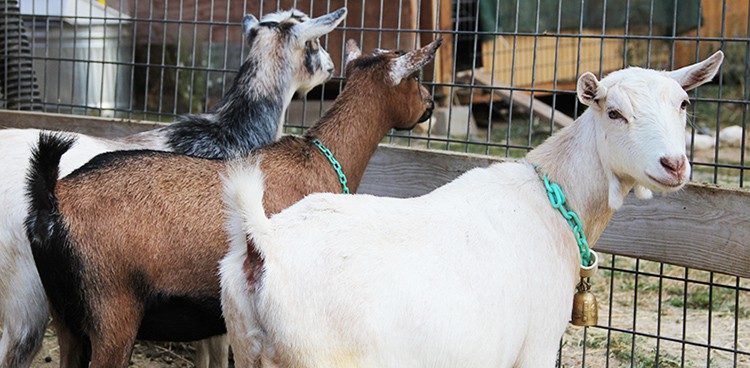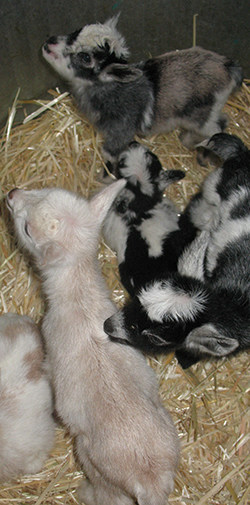
Origin and History
Although the earliest origins of the Nigerian Dwarf goat trace back to the African continent, there’s little evidence to suggest that the breed’s name accurately reflects either its country of origin or its genetic makeup. In fact, Nigerian Dwarfs are not from Nigeria, nor are they true genetic dwarfs. And while they do share many characteristics, Nigerian Dwarfs should not be confused with Pygmy goats, as the two have become distinctly different breeds since their arrival in the United States.
Both Nigerian Dwarfs and Pygmy goats likely descended from West African Dwarf goats. These animals provided milk and meat for the local population. Beginning in the 1930s, they became meals for lions and other carnivorous animals on their trans-oceanic journey from the great plains of Africa to zoos across America. Over time, the lucky goats not consumed en route earned their own exhibits, and as their populations grew, zoos sold surplus stock to research institutions and private individuals.
Once freed from the confines of our nation’s zoological parks, Nigerians were crossed with many breeds, including San Clementes, Spanish meat goats, and other small-statured varieties. In 1981, the American Goat Society finally recognized the Nigerian Dwarf Dairy goat as a distinct breed, and in 2005 the American Dairy Goat Association gave the breed its own purebred herdbook, making it the most recently recognized dairy breed in the U.S. today.
Appearance and Temperament
Nigerian Dwarfs are a thrifty, low-maintenance breed with few requirements in terms of space or special care. This makes them ideal candidates for the home dairy or hobby farmer. Does usually measure well under the breed standard’s 22.5-inch height limit, while bucks often approach the breed’s 23.5-inch maximum. Unlike their Pygmy relatives, who often sport a stout, stocky build, Nigerians are more like well-proportioned miniatures of the larger dairy goat breeds. They come in an astonishing assortment of colors, from white, black and red to patterns such as buckskin and chamoisee.
According to Gianaclis Caldwell, a goat cheese maker and co-owner of Pholia Farm Creamery in Rogue River, Oregon, Nigerians come in a vast range of temperaments too. Caldwell was originally drawn to Nigerians because of their small size—both Gianaclis and her husband, Vern, were hoping to get an animal small enough that their young daughter could get involved with the daily routine of caretaking—and the tiny African goats fit the bill perfectly. “They are great for older adults and children. Their size just makes them much easier to work with,” notes Caldwell. “On the other hand,” she adds, “for the amount of milk you get, you have more animals to tend!”
Milk and Cheeses
Caldwell, whose Pholia Farm cheeses are made from 100 percent Nigerian Dwarf goat milk, explains that the breed’s milk is the most full-bodied of the (recognized) dairy goats. “The smaller the animal, the denser the milk!” she notes. Caldwell refers to the Nigerian’s milk as her “secret weapon” because the milk’s average 5.5 to 7 percent butterfat content makes it ideal for cheesemaking. Nigerian milk also has more of the alpha S1 protein, commonly referred to as the “cheese” protein. A high percentage of alpha S1 leads to higher yield, as well as producing cheeses with exceptionally rich characteristics.
Pholia Farm Creamery mostly produces aged, raw milk hard cheeses (aged three to eight months), which Caldwell describes as dense and not at all “goaty.” For this type of cheese Caldwell says her yield is between 15 and 18 percent (compared to 10 to 11 percent for an average cow). Though Pholia Farm does not make fresh chèvre, Caldwell notes that if they were to make soft-style cheeses, this impressive percentage would creep even higher. Finally, she notes with obvious pleasure, because of Nigerian milk’s high butterfat content and its sweet, mellow flavor, “it also makes delicious ice cream.”
Photos by Gianiclis Caldwell





